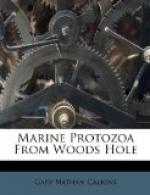Acineta divisa Fraipont ’79. Fig. 67.
This extremely graceful form is common on Bryozoa at Woods Hole. The cup is shaped like a wine glass and is specifically characterized by a cup-formed membrane upon which the animal rests. The animal thus has the appearance of being suspended on the edge of the cup. The stalk is slender and about 4 times the length of the body. The tentacles are all capitate and distributed, and about 2-1/2 times the body length. They sway back and forth very slowly. The nucleus is spherical and central in position. The contractile vacuole lies near the periphery.
Length of body 27 mu; of stalk 100 mu; of extended tentacle 65 mu.
[Illustration: Fig. 67.—Acineta divisa.]
Acineta tuberosa Ehr. Fig. 68.
Large forms of Suctoria with tentacles arranged in fascicles. The stalk is variable in length and the cup is frequently so delicate that it can barely be made out. A specific characteristic is the break in continuity of the cup at different points, and through these places the tentacles emerge in bundles. The tentacles are capitate and in the Woods Hole form, 15 in number in each of the two bundles. The endoplasm is granular and yellowish in color. The coloring matter is frequently arranged in patterns. The nucleus is spheroidal. The contractile vacuole is in the anterior third of the body about midway between the bundles of tentacles. Reproduction not observed.
Length of body 330 mu.
[Illustration: Fig. 68.—Acineta tuberosa.]
Genus TRICHOPHRYA Clap. & Lach. ’58.
(See Kent ’81; Entz ’84; Buetschli ’88; Sand 1901.)
Small forms to medium size; no cups or stalks. The body is spherical to elongate, usually, however, more or less irregularly lobed and changeable. The tentacles are in fascicles which are usually borne upon lobed or swollen places. The body is always more or less spread out. Contractile vacuoles variable. The macronucleus is spherical, elongate, band-formed or horseshoe-shaped. Reproduction takes place by endogenous budding, and the swarm spores are flat or lenticular with a distinct ciliary girdle. They are frequently parasitic. Fresh and salt water.
Trichophrya salparum Entz ’84. Fig. 69.
Buetschli ’88; Schewiakoff ’93; Trichophrya
ascidiarum Lachmann ’59;
Rene Sand 1901.
The body is somewhat cup-form, with a large, flat base. The anterior border is rounded, each of the ends being somewhat truncate and carrying a bundle of tentacles all capitate and similar. These may be continued internally as far as the nucleus (Sand). The cytoplasm is uncolored, but may contain some brilliant granules. The nucleus is granular, and spherical, band or horseshoe formed.
[Illustration: Fig. 69.—Trichophrya salparum.]
This species was found by Dr. G. Hunter on the branchial bars of the Ascidian Molgula manhattensis, where great numbers of them are often parasitic.




